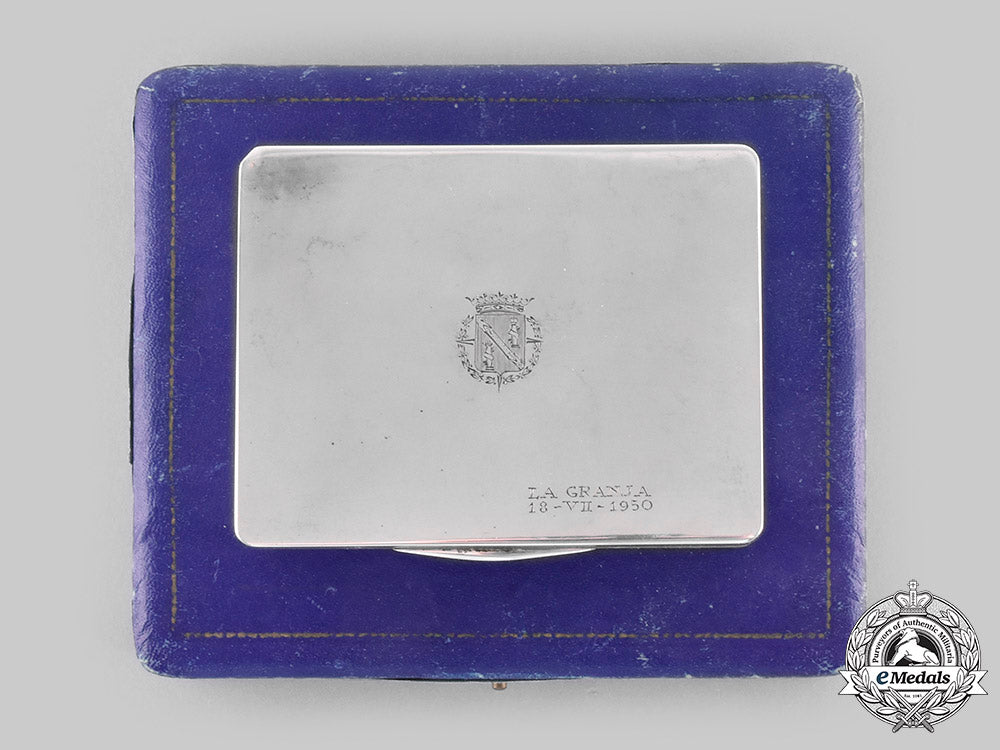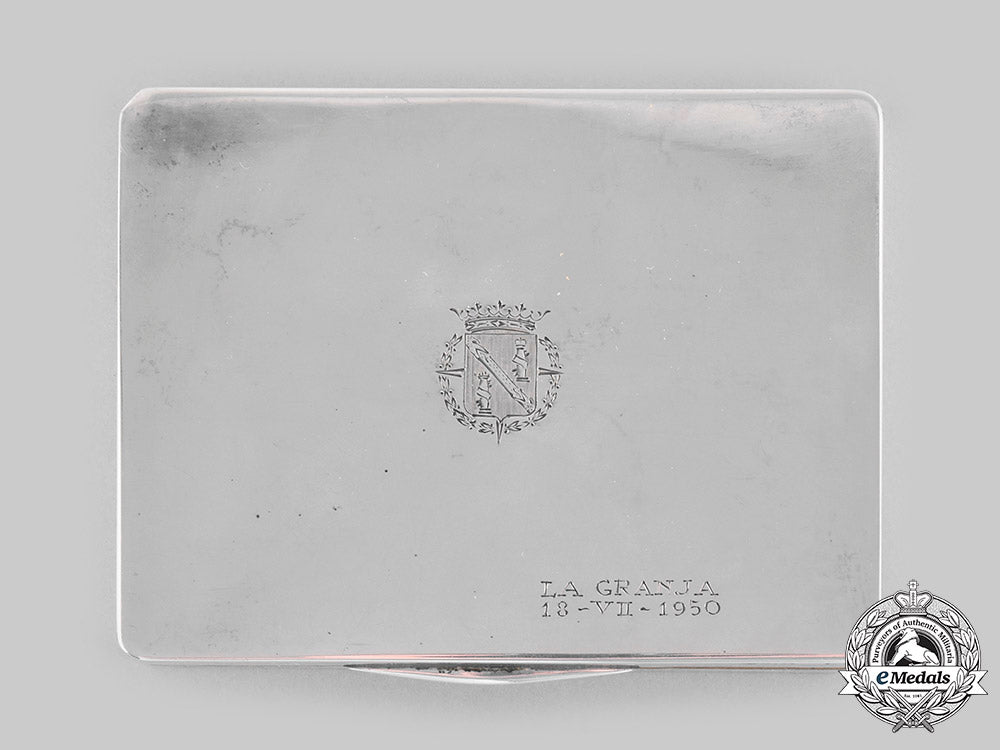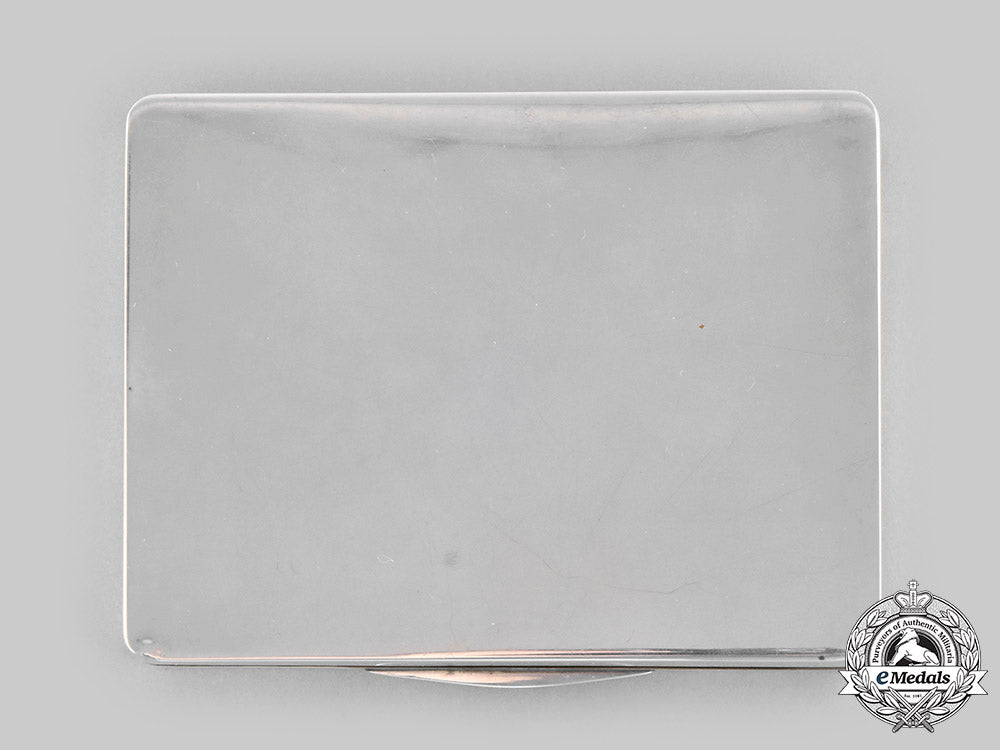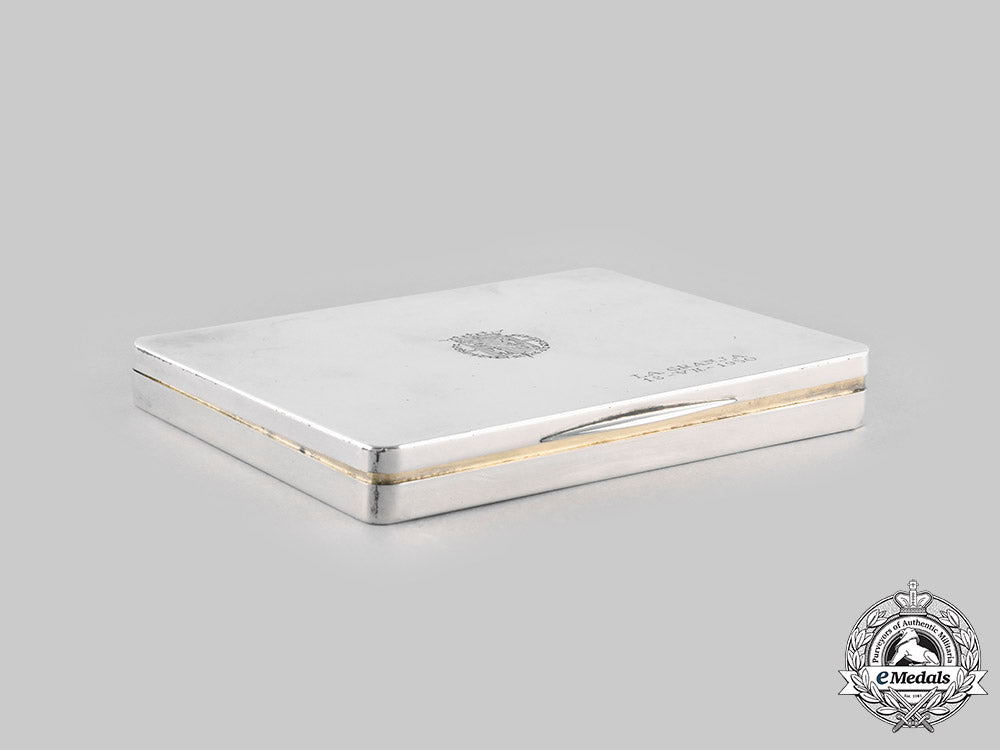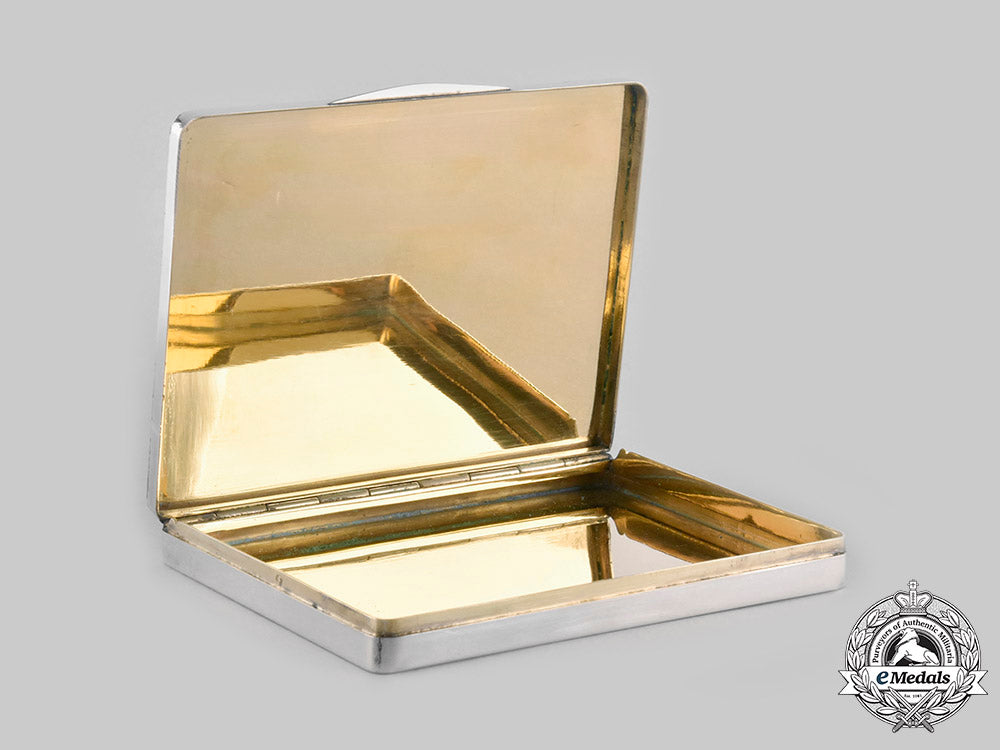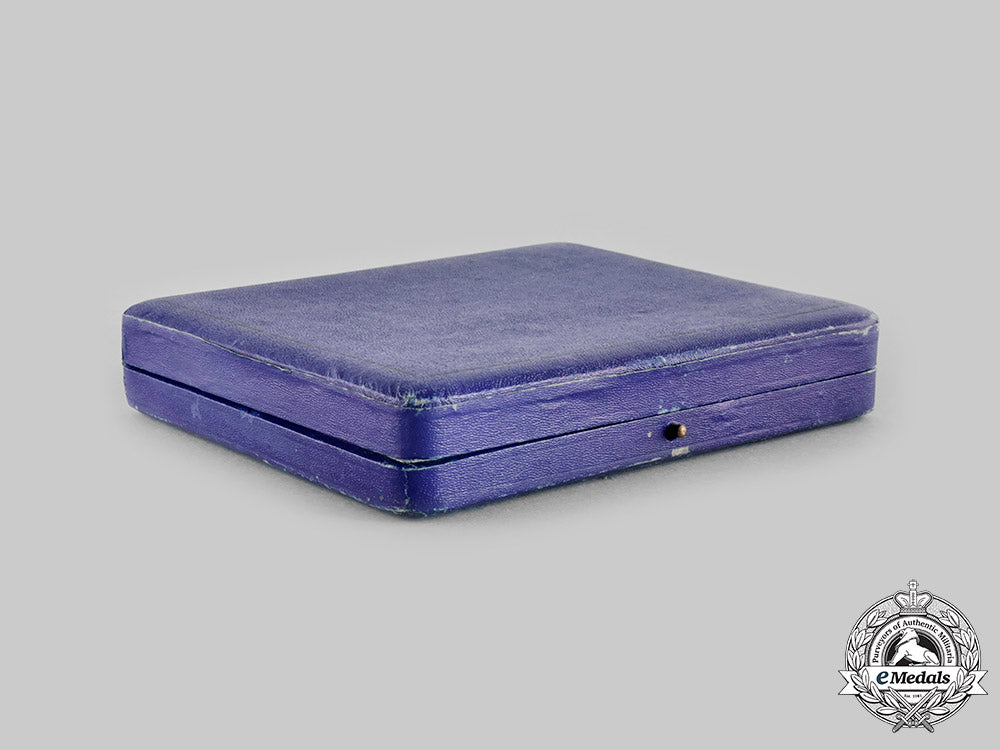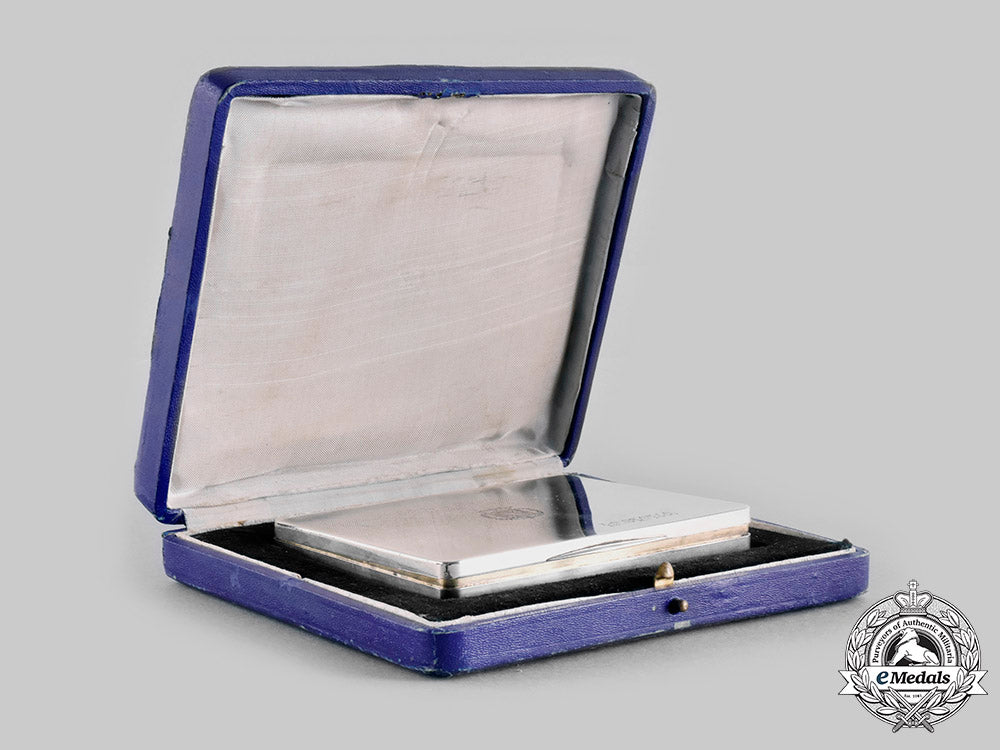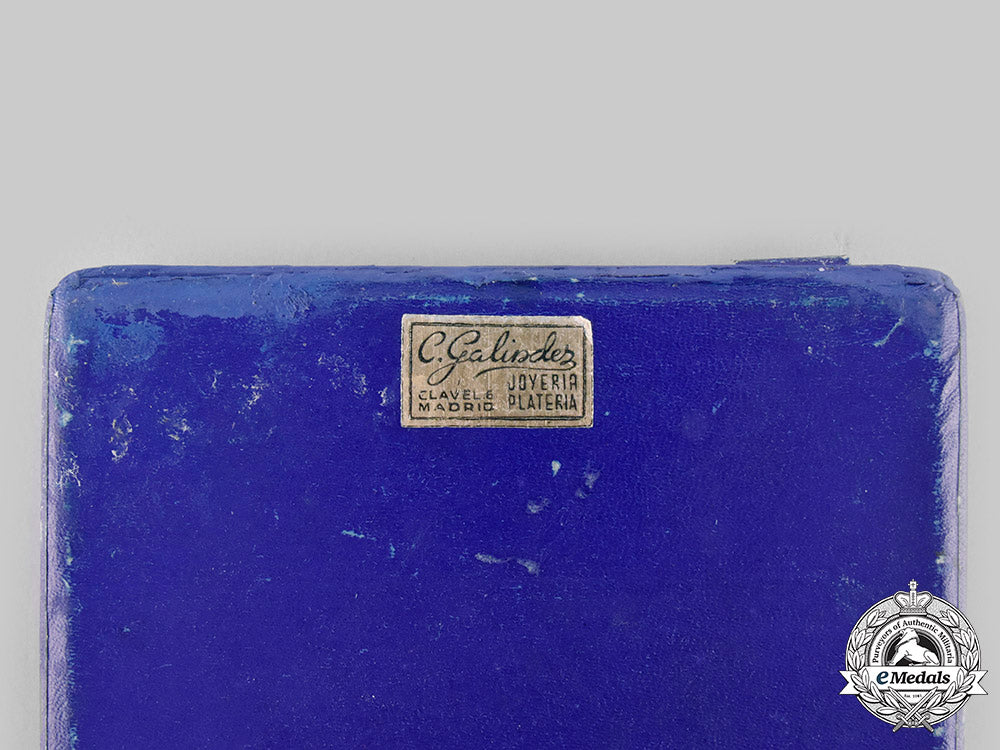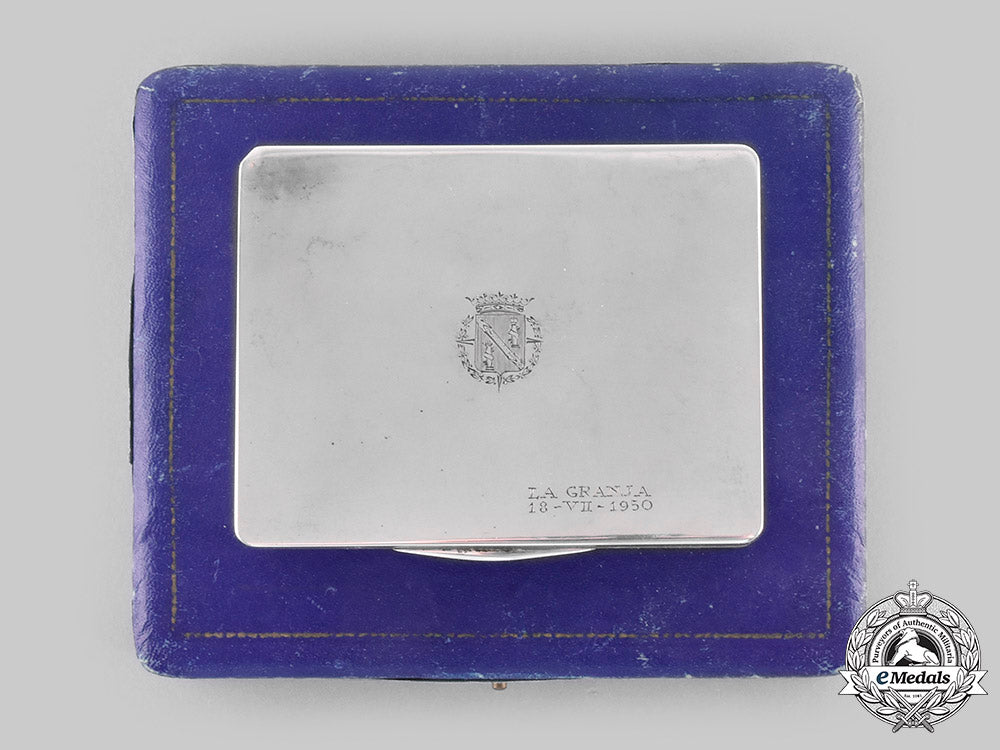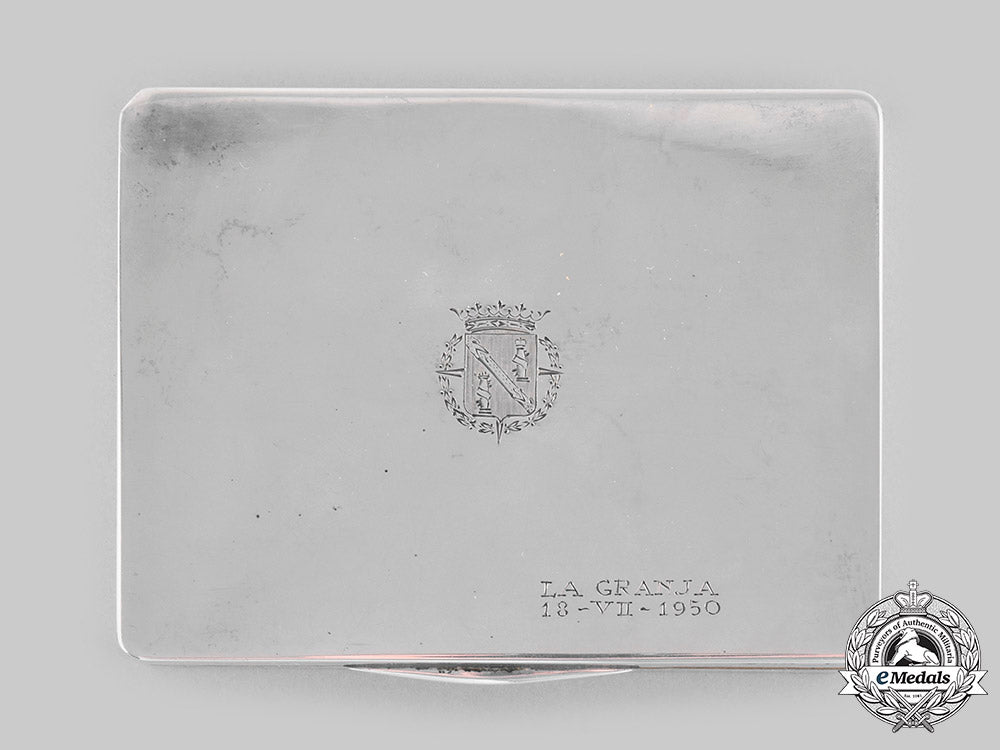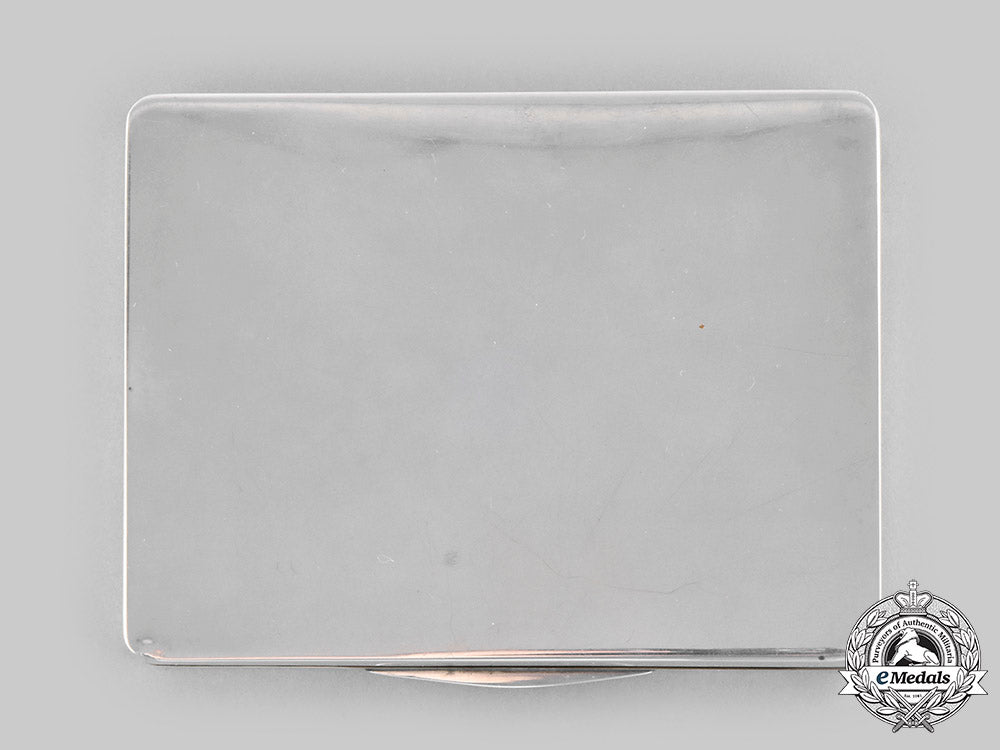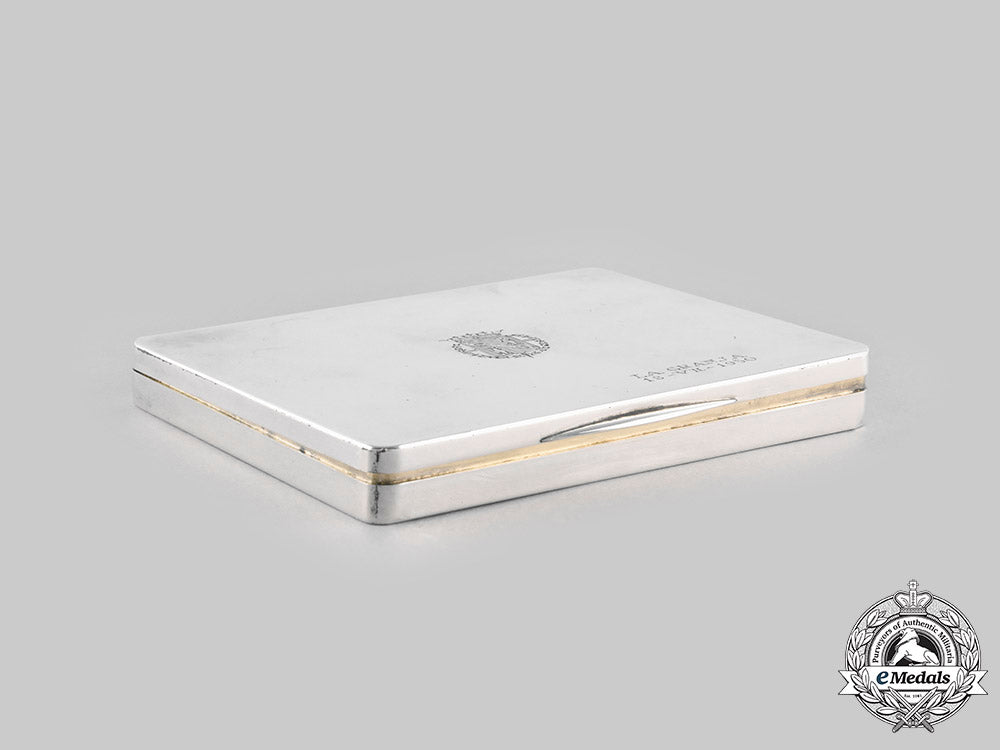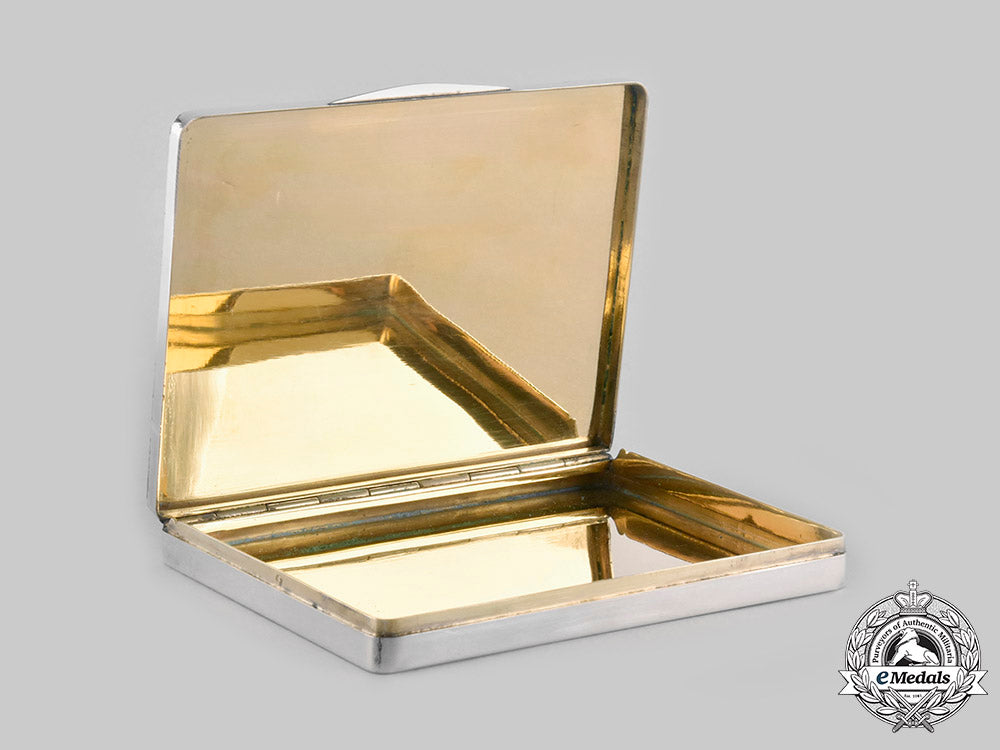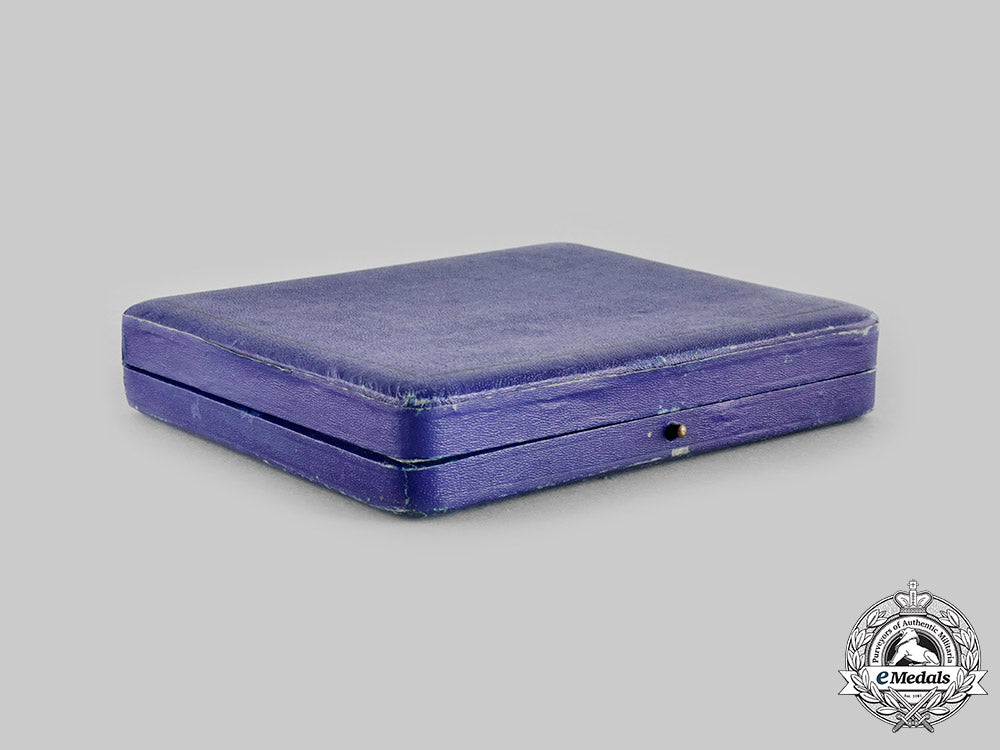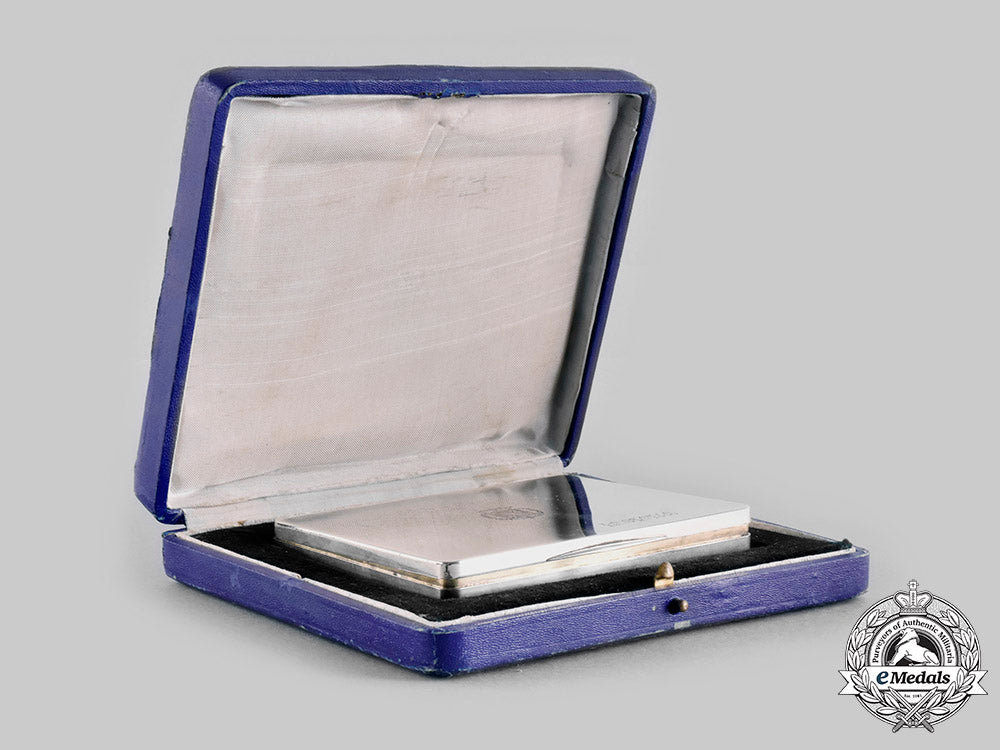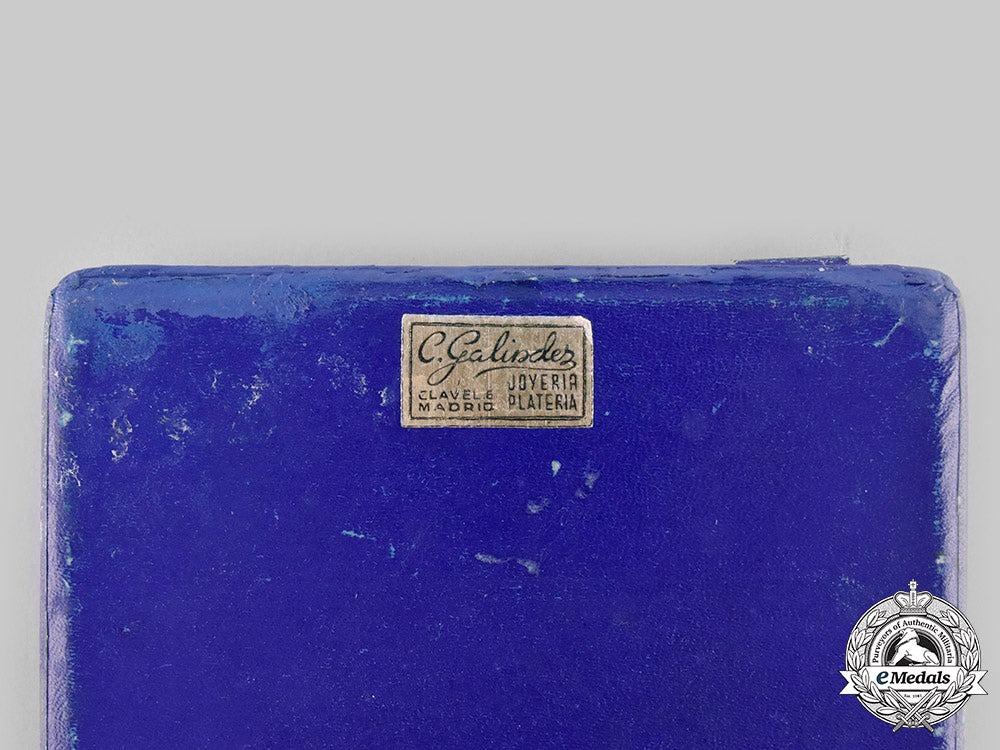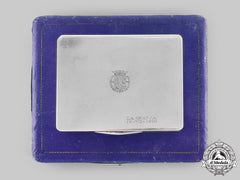
LOADING ...
In response to evolving domestic opinion, eMedals Inc has made the conscious decision to remove the presentation of German Third Reich historical artifacts from our online catalogue. For three decades, eMedals Inc has made an effort to preserve history in all its forms. As historians and researchers, we have managed sensitive articles and materials with the greatest of care and respect for their past and present social context. We acknowledge the growing sentiments put forth by the Canadian public and have taken proactive actions to address this opinion.
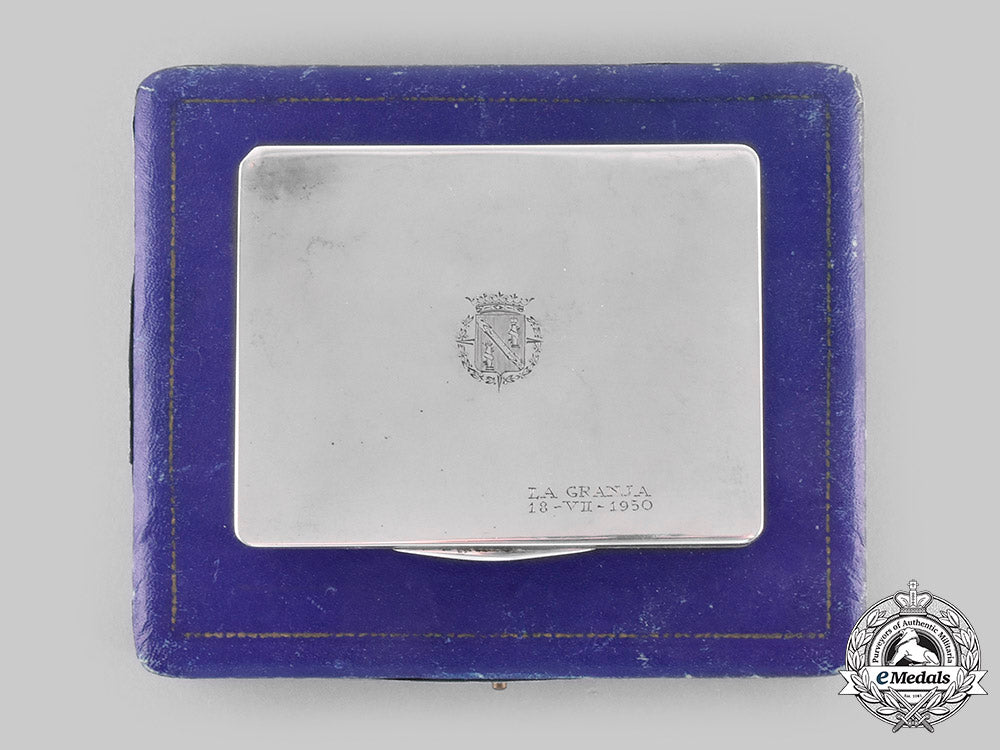
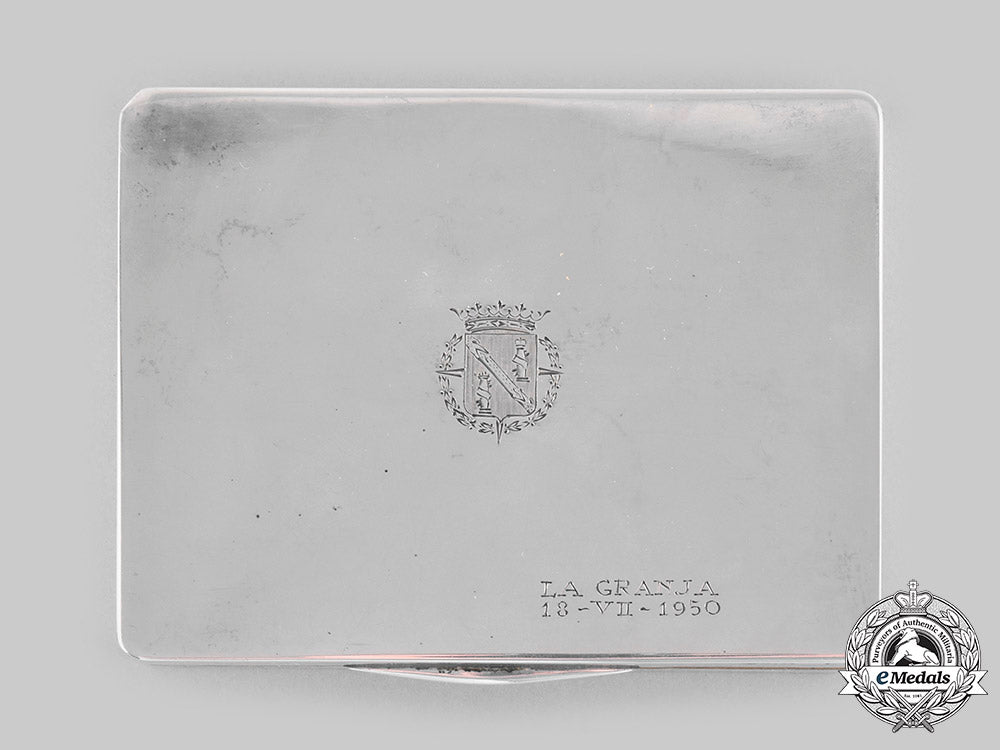
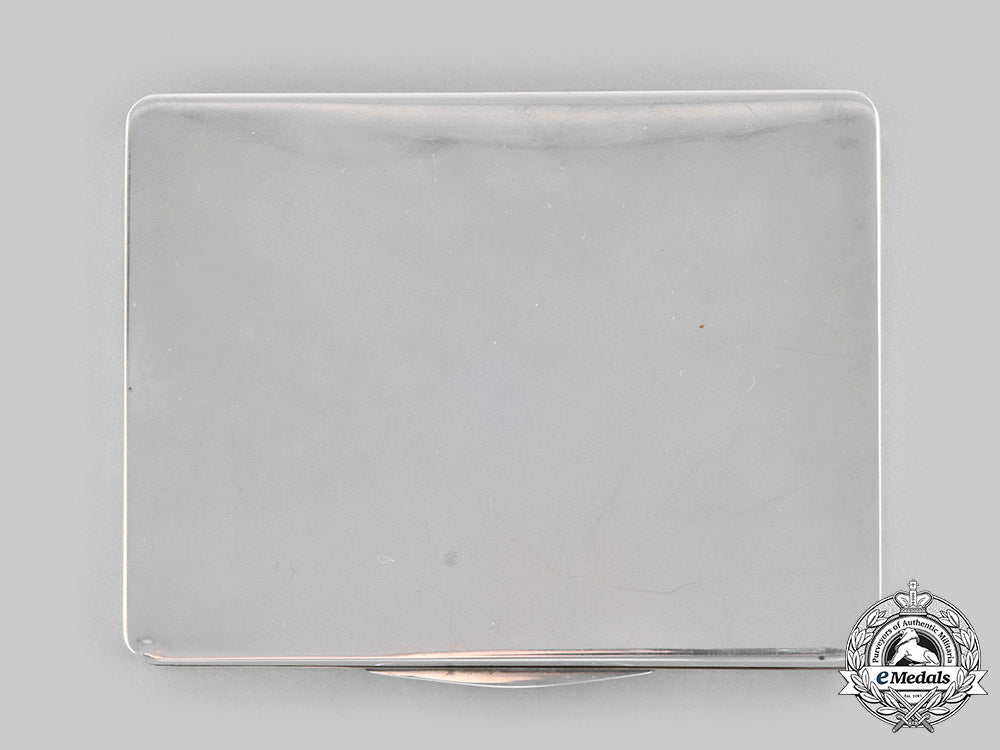
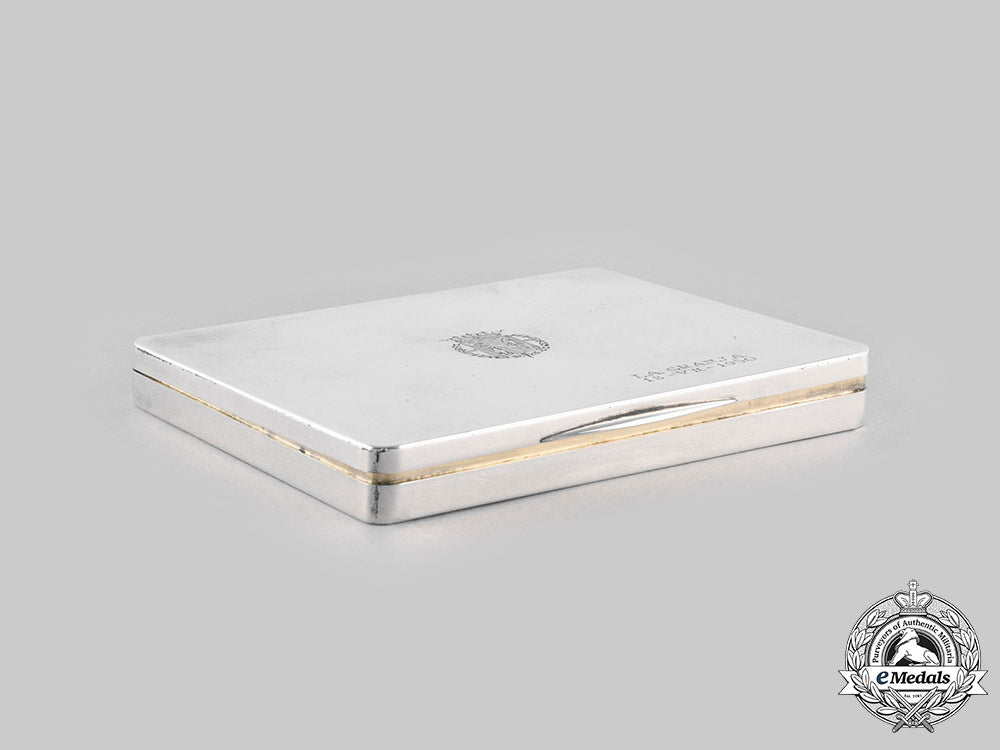
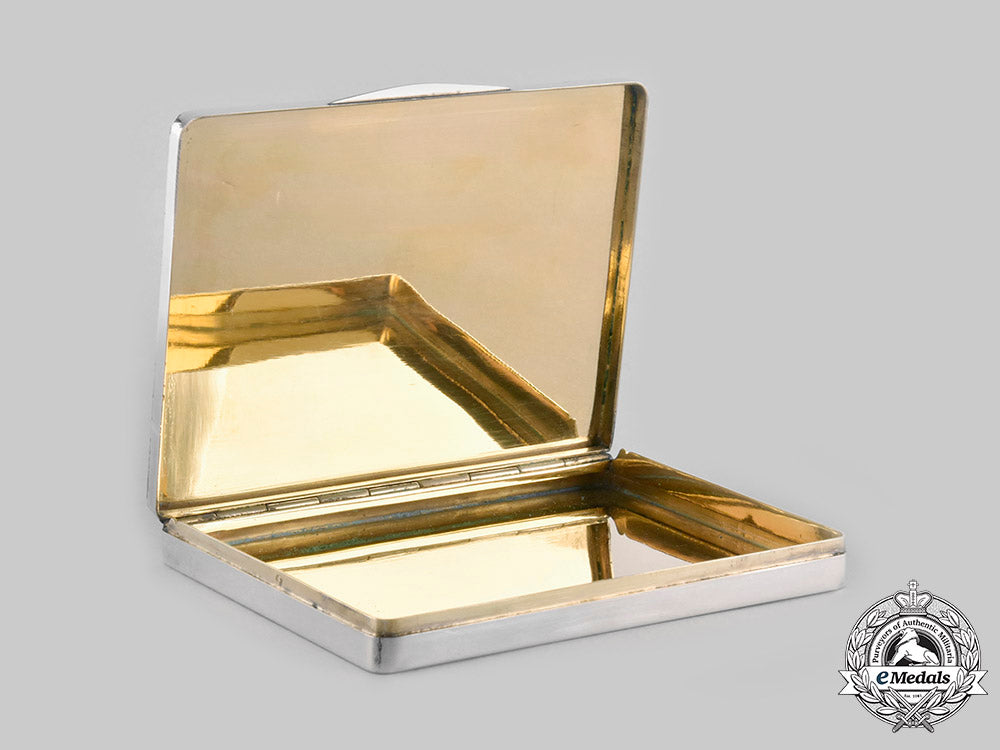
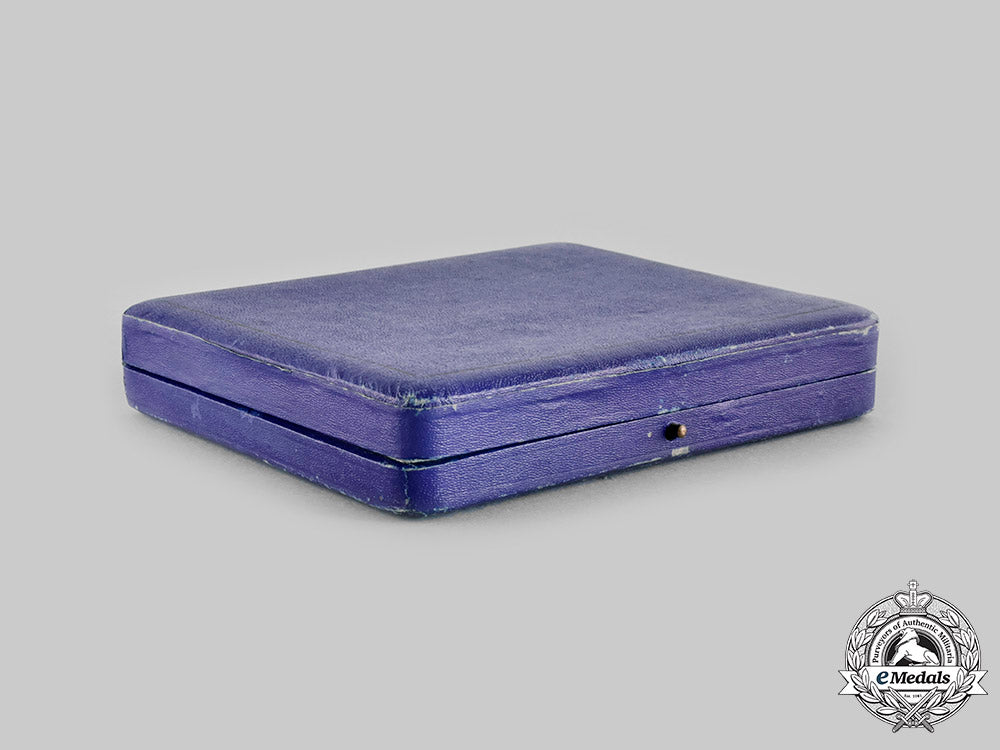
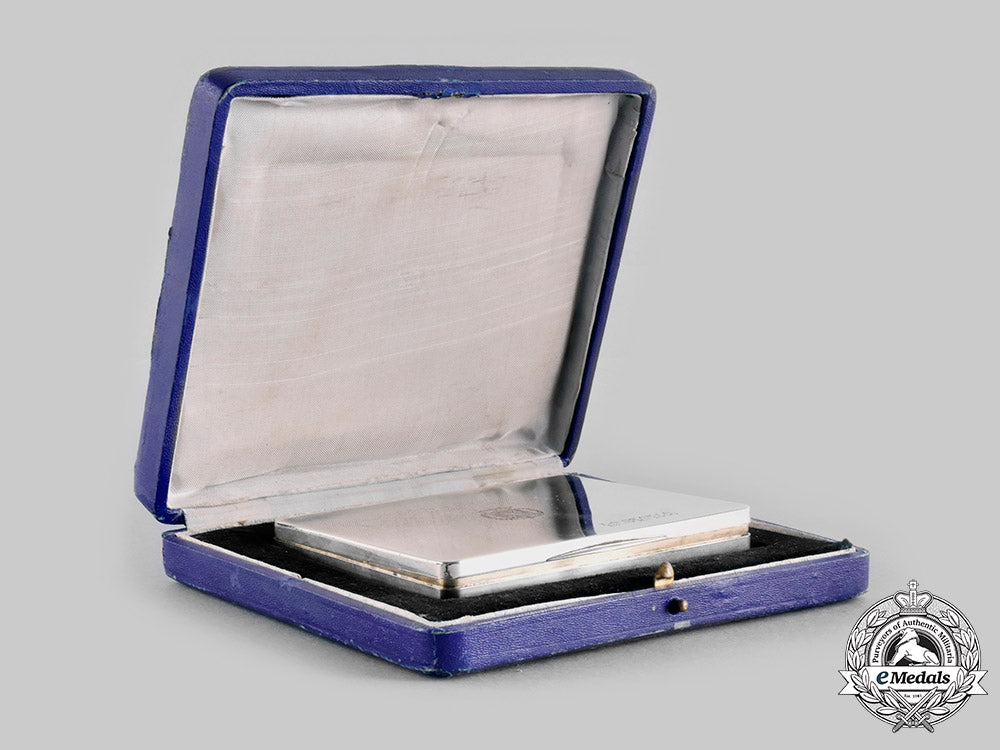

Spain, Facist State. A Cigarette Case Of Francisco Franco, C.1950
Spain, Facist State. A Cigarette Case Of Francisco Franco, C.1950
SKU: ITEM: M0540-91
Current Bid:
Your Max Bid:
Bid History:
Time Remaining:
Couldn't load pickup availability
Shipping Details
Shipping Details
eMedals offers rapid domestic and international shipping. Orders received prior to 12:00pm (EST) will be shipped on the same business day.* Orders placed on Canadian Federal holidays will be dispatched the subsequent business day. Courier tracking numbers are provided for all shipments. All items purchased from eMedals can be returned for a full monetary refund or merchandise credit, providing the criteria presented in our Terms & Conditions are met. *Please note that the addition of a COA may impact dispatch time.
Shipping Details
eMedals offers rapid domestic and international shipping. Orders received prior to 12:00pm (EST) will be shipped on the same business day.* Orders placed on Canadian Federal holidays will be dispatched the subsequent business day. Courier tracking numbers are provided for all shipments. All items purchased from eMedals can be returned for a full monetary refund or merchandise credit, providing the criteria presented in our Terms & Conditions are met. *Please note that the addition of a COA may impact dispatch time.
Description
Description
A rectangular cigarette case constructed of silver with interior gold plating, the exterior lid bears the hand etched personal coat of arms of Francisco Franco: a shield with a left-to-right diagonal field with two creatures with their tongues out, the left and right fields that are created with this division both bear a column of Hercules, the lower column is topped with the imperial crown and the upper column is topped with the national crown, encompassed by a wreath and superimposed over a cross with pointed arms, topped with a crown; the bottom right corner of the lid is inscribed with “LA GRANJA 18 - VII - 1950” (the fourteen year anniversary of the outbreak of the Spanish Civil War), with a hinge at the twelve o’clock position and a push latch at the six o’clock position, the interior is plain and gold plated, the lip of the bottom part of the case bears a (unknown) hallmark, measuring 104.18 mm (w) x 82.56 mm (h), weighing 153.7 grams, extremely fine.
Accompanied by a rectangular case constructed of a royal blue pebbled faux leatherette, the exterior lid bears a rectangular gilded border and the bottom bears a label reading “C. Galindez JOYERIA PLATERIA CLAVEL & MADRID”, with a push button latch, the interior lid is of an off-white satin fabric, the bed of the case is a black velvet with recessed bed for the cigarette case, measuring 150 mm (w) x 126 mm (h), some scuffing but otherwise in extremely fine condition.
Footnote: Francisco Franco was born on 4 December 1892 in El Ferrol, Spain into a Catholic upper class family. His father was an officer in the Spanish Navy and Franco was meant to follow in his footsteps, but by the time he reached the age to enter the Naval Academy they were no longer accepting applicants due to the Spanish-American War. As a result, Franco entered the Infantry Academy in Toledo in 1907 and graduated in July 1910 as second lieutenant.
In June 1912, at age nineteen, Franco was promoted to the rank of first lieutenant. In 1914, Franco was commissioned to Morocco. In 1916, Franco had been promoted to captain at the young age of twenty-three. He was shot in the abdomen by a machine gun and received the Cross of Maria Cristina, First Class. At the end of February 1917 at age twenty-four, Franco moved up the ranks yet again to major; this made him the youngest major in the Spanish army. From 1917 to 1920, he served in Spain. In 1920, Lieutenant Colonel José Millán Astray founded the Spanish Foreign Legion, and Franco became the Legion's second-in-command and returned to Africa.In 1923, by now a lieutenant colonel, he was made commander of the Legion.
On 22 October 1923, Franco married María del Carmen Polo y Martínez-Valdès (11 June 1900 – 6 February 1988) and three years later on 14 September 1926, the couple had a daughter, María del Carmen.
Promoted to colonel, Franco led the first wave of troops ashore at Al Hoceima (Spanish: Alhucemas) in 1925. He was promoted to brigadier general on 3 February 1926 for his efforts against Abd el-Krim's tribe. This made him the youngest general in Spain, quite possibly one of the youngest generals in Europe. In 1928, Franco was appointed director of the newly created General Military Academy of Zaragoza, a new college for all army cadets, replacing the former separate institutions for young men seeking to become officers in artillery, infantry, cavalry, and other branches of the army. In 1931, Franco was removed as Director, but this position would highly benefit him in his later military and political endeavours.
With the fall of the monarchy in 1931, Franco did not take any notable stand. The closing of the Academy in June by War Minister Manuel Azaña provoked Franvo’s first clash with the Spanish Republic. Azaña found Franco's farewell speech to the cadets insulting as Franco stressed the Republic's need for discipline and respect. As a result, Franco was without a post and under surveillance for six months.
Franco was a subscriber to the journal of Acción Española, a monarchist organisation, and a firm believer in the Jewish-Masonic-Bolshevik conspiracy. On 5 February 1932, he was given a command in A Coruña. That same year José Sanjurjo attempted a coup against the Spanish government, but Franco disapproved and avoided any involvement. In January 1933, Franco was demoted from the first to the twenty-fourth on the list of brigadiers, but on 17 February he was given military command of the Balearic Islands - a post above his rank. However, he was still frustrated that he was placed in positions he did not wish to be in. After the election in 1933, Asturian strikers led an insurgency in which Franco, already General of Division and aide to the war minister, Diego Hidalgo, was put in command of the operations directed to suppress.
On 23 February 1936, Franco was sent to the Canary Islands to serve as the islands' military commander. This position was perceived by him as a punishment and banishment.
Franco intended to stand as a candidate of the Right Bloc alongside José Antonio Primo de Rivera for the by-election in the province of Cuenca scheduled for 3 May 1936, after the results of the February 1936 election were annulled in the constituency. However, Primo de Rivera refused to run in an election alongside a military officer - especially Franco. Franco ended up pulling out of the election on 26 April. In June 1936, Franco was contacted for a secret meeting on Tenerife to discuss a military coup. He ultimately chose the side of the rebels and was put in charge of the army in Africa.
The coup had not produced a complete victory for the insurgents and on 18 July 1936 the Spanish Civil War began. The designated leader of the uprising, General José Sanjurjo, died on 20 July 1936, in a plane crash. Command was divided into regional commands (Emilio Mola in the North, Gonzalo Queipo de Llano in Seville commanding Andalusia, Franco with an independent command and Miguel Cabanellas in Zaragoza commanding Aragon). The Spanish Army of Morocco itself was split into two columns, commanded by General Juan Yagüe and Colonel José Varela. On 1 October 1936, Franco was publicly proclaimed as Generalísimo of the National army and Jefe del Estado (Head of State).
Franco was supported throughout the Spanish Civil War by both Hitler and Mussolini. Victory was declared on 1 April 1939 and the war ended. Historians estimate that the total of people executed during the civil war was approximately 120,000 and after the civil war between 15,000 and 35,000.
Franco’s interactions with Germany and Italy during the Second World War continued, although with caution. Spain never formally supported the Allied or Axis powers; however, he had met with Hitler to discuss Spain’s entry into the war on the side of the Axis powers. His requests including supplies of food and fuel, as well as Spanish control of Gibraltar and French North Africa, proved too much for Hitler and no agreement was made. Volunteer Spanish troops (the División Azul, or "Blue Division") fought on the Eastern Front under German command from 1941 to 1944, but were not permitted to fight on the Western Front against other Allied powers.
Franco implemented Francoism as head of the government. He ruled over Spain almost exclusively by decree. He nurtured a cult of personality and the Movimiento Nacional became the only channel of participation in Spanish public life. His Francoist dictatorship continued to soften over time and Luis Carrero Blanco became Franco's éminence grise, controlling the day-to-day operations of the government: this increased when Franco began showing symptoms of Parkinson's disease in the 1960s. In 1973, Franco resigned as Prime Minister as he was suffering from Parkinson’s disease and the ailments of old age. Franco died on 20 November 1975 and was buried in the Valle de los Caídos. His body was exhumed on 24 October 2019 from the Valle de los Caidos and moved to his wife's mausoleum located in the Mingorrubio Cemetery.
Franco remains a controversial figure in Spanish history for the nature of his dictatorship. His reign was marked by both brutal repression, with thousands killed, but also economic prosperity, which greatly improved the quality of life in Spain. His dictatorial style proved very adaptable, which could introduce social and economic reform, and the only consistent points in Franco's long rule were above all authoritarianism, Spanish nationalism, national Catholicism, anti-Freemasonry, anti-anarchism and anti-communism.
Description
A rectangular cigarette case constructed of silver with interior gold plating, the exterior lid bears the hand etched personal coat of arms of Francisco Franco: a shield with a left-to-right diagonal field with two creatures with their tongues out, the left and right fields that are created with this division both bear a column of Hercules, the lower column is topped with the imperial crown and the upper column is topped with the national crown, encompassed by a wreath and superimposed over a cross with pointed arms, topped with a crown; the bottom right corner of the lid is inscribed with “LA GRANJA 18 - VII - 1950” (the fourteen year anniversary of the outbreak of the Spanish Civil War), with a hinge at the twelve o’clock position and a push latch at the six o’clock position, the interior is plain and gold plated, the lip of the bottom part of the case bears a (unknown) hallmark, measuring 104.18 mm (w) x 82.56 mm (h), weighing 153.7 grams, extremely fine.
Accompanied by a rectangular case constructed of a royal blue pebbled faux leatherette, the exterior lid bears a rectangular gilded border and the bottom bears a label reading “C. Galindez JOYERIA PLATERIA CLAVEL & MADRID”, with a push button latch, the interior lid is of an off-white satin fabric, the bed of the case is a black velvet with recessed bed for the cigarette case, measuring 150 mm (w) x 126 mm (h), some scuffing but otherwise in extremely fine condition.
Footnote: Francisco Franco was born on 4 December 1892 in El Ferrol, Spain into a Catholic upper class family. His father was an officer in the Spanish Navy and Franco was meant to follow in his footsteps, but by the time he reached the age to enter the Naval Academy they were no longer accepting applicants due to the Spanish-American War. As a result, Franco entered the Infantry Academy in Toledo in 1907 and graduated in July 1910 as second lieutenant.
In June 1912, at age nineteen, Franco was promoted to the rank of first lieutenant. In 1914, Franco was commissioned to Morocco. In 1916, Franco had been promoted to captain at the young age of twenty-three. He was shot in the abdomen by a machine gun and received the Cross of Maria Cristina, First Class. At the end of February 1917 at age twenty-four, Franco moved up the ranks yet again to major; this made him the youngest major in the Spanish army. From 1917 to 1920, he served in Spain. In 1920, Lieutenant Colonel José Millán Astray founded the Spanish Foreign Legion, and Franco became the Legion's second-in-command and returned to Africa.In 1923, by now a lieutenant colonel, he was made commander of the Legion.
On 22 October 1923, Franco married María del Carmen Polo y Martínez-Valdès (11 June 1900 – 6 February 1988) and three years later on 14 September 1926, the couple had a daughter, María del Carmen.
Promoted to colonel, Franco led the first wave of troops ashore at Al Hoceima (Spanish: Alhucemas) in 1925. He was promoted to brigadier general on 3 February 1926 for his efforts against Abd el-Krim's tribe. This made him the youngest general in Spain, quite possibly one of the youngest generals in Europe. In 1928, Franco was appointed director of the newly created General Military Academy of Zaragoza, a new college for all army cadets, replacing the former separate institutions for young men seeking to become officers in artillery, infantry, cavalry, and other branches of the army. In 1931, Franco was removed as Director, but this position would highly benefit him in his later military and political endeavours.
With the fall of the monarchy in 1931, Franco did not take any notable stand. The closing of the Academy in June by War Minister Manuel Azaña provoked Franvo’s first clash with the Spanish Republic. Azaña found Franco's farewell speech to the cadets insulting as Franco stressed the Republic's need for discipline and respect. As a result, Franco was without a post and under surveillance for six months.
Franco was a subscriber to the journal of Acción Española, a monarchist organisation, and a firm believer in the Jewish-Masonic-Bolshevik conspiracy. On 5 February 1932, he was given a command in A Coruña. That same year José Sanjurjo attempted a coup against the Spanish government, but Franco disapproved and avoided any involvement. In January 1933, Franco was demoted from the first to the twenty-fourth on the list of brigadiers, but on 17 February he was given military command of the Balearic Islands - a post above his rank. However, he was still frustrated that he was placed in positions he did not wish to be in. After the election in 1933, Asturian strikers led an insurgency in which Franco, already General of Division and aide to the war minister, Diego Hidalgo, was put in command of the operations directed to suppress.
On 23 February 1936, Franco was sent to the Canary Islands to serve as the islands' military commander. This position was perceived by him as a punishment and banishment.
Franco intended to stand as a candidate of the Right Bloc alongside José Antonio Primo de Rivera for the by-election in the province of Cuenca scheduled for 3 May 1936, after the results of the February 1936 election were annulled in the constituency. However, Primo de Rivera refused to run in an election alongside a military officer - especially Franco. Franco ended up pulling out of the election on 26 April. In June 1936, Franco was contacted for a secret meeting on Tenerife to discuss a military coup. He ultimately chose the side of the rebels and was put in charge of the army in Africa.
The coup had not produced a complete victory for the insurgents and on 18 July 1936 the Spanish Civil War began. The designated leader of the uprising, General José Sanjurjo, died on 20 July 1936, in a plane crash. Command was divided into regional commands (Emilio Mola in the North, Gonzalo Queipo de Llano in Seville commanding Andalusia, Franco with an independent command and Miguel Cabanellas in Zaragoza commanding Aragon). The Spanish Army of Morocco itself was split into two columns, commanded by General Juan Yagüe and Colonel José Varela. On 1 October 1936, Franco was publicly proclaimed as Generalísimo of the National army and Jefe del Estado (Head of State).
Franco was supported throughout the Spanish Civil War by both Hitler and Mussolini. Victory was declared on 1 April 1939 and the war ended. Historians estimate that the total of people executed during the civil war was approximately 120,000 and after the civil war between 15,000 and 35,000.
Franco’s interactions with Germany and Italy during the Second World War continued, although with caution. Spain never formally supported the Allied or Axis powers; however, he had met with Hitler to discuss Spain’s entry into the war on the side of the Axis powers. His requests including supplies of food and fuel, as well as Spanish control of Gibraltar and French North Africa, proved too much for Hitler and no agreement was made. Volunteer Spanish troops (the División Azul, or "Blue Division") fought on the Eastern Front under German command from 1941 to 1944, but were not permitted to fight on the Western Front against other Allied powers.
Franco implemented Francoism as head of the government. He ruled over Spain almost exclusively by decree. He nurtured a cult of personality and the Movimiento Nacional became the only channel of participation in Spanish public life. His Francoist dictatorship continued to soften over time and Luis Carrero Blanco became Franco's éminence grise, controlling the day-to-day operations of the government: this increased when Franco began showing symptoms of Parkinson's disease in the 1960s. In 1973, Franco resigned as Prime Minister as he was suffering from Parkinson’s disease and the ailments of old age. Franco died on 20 November 1975 and was buried in the Valle de los Caídos. His body was exhumed on 24 October 2019 from the Valle de los Caidos and moved to his wife's mausoleum located in the Mingorrubio Cemetery.
Franco remains a controversial figure in Spanish history for the nature of his dictatorship. His reign was marked by both brutal repression, with thousands killed, but also economic prosperity, which greatly improved the quality of life in Spain. His dictatorial style proved very adaptable, which could introduce social and economic reform, and the only consistent points in Franco's long rule were above all authoritarianism, Spanish nationalism, national Catholicism, anti-Freemasonry, anti-anarchism and anti-communism.
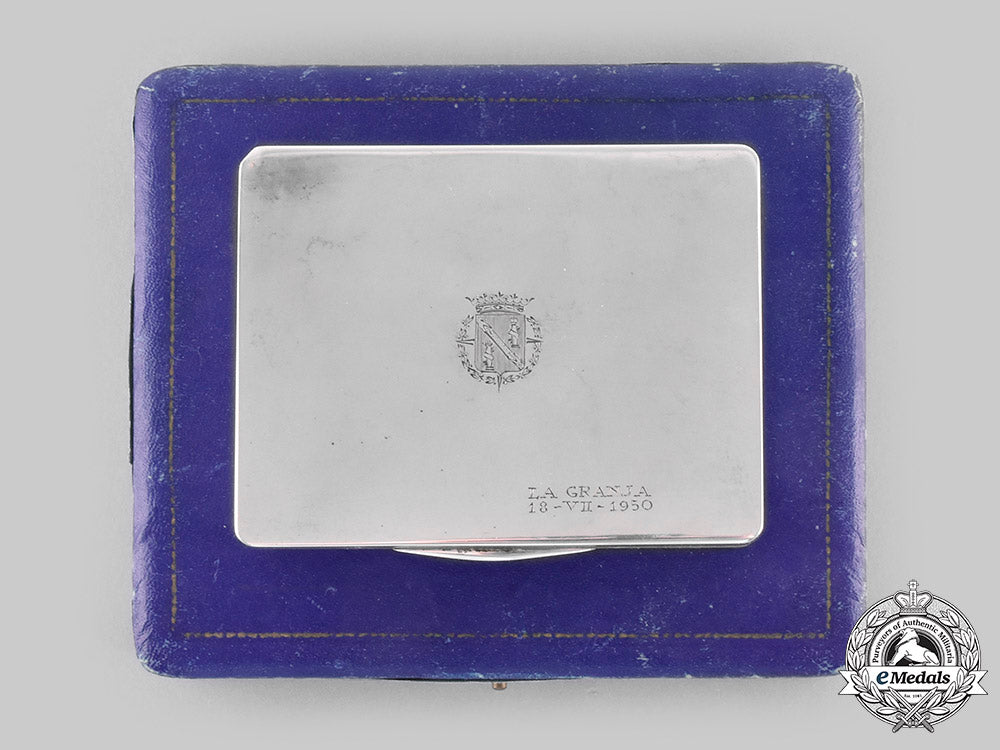
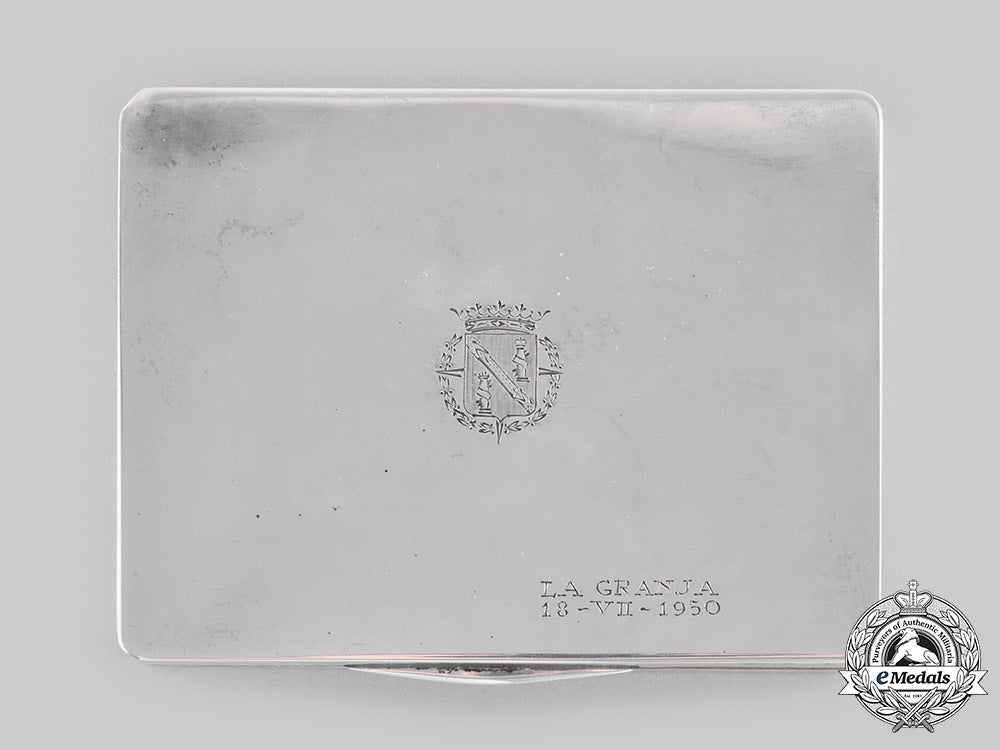
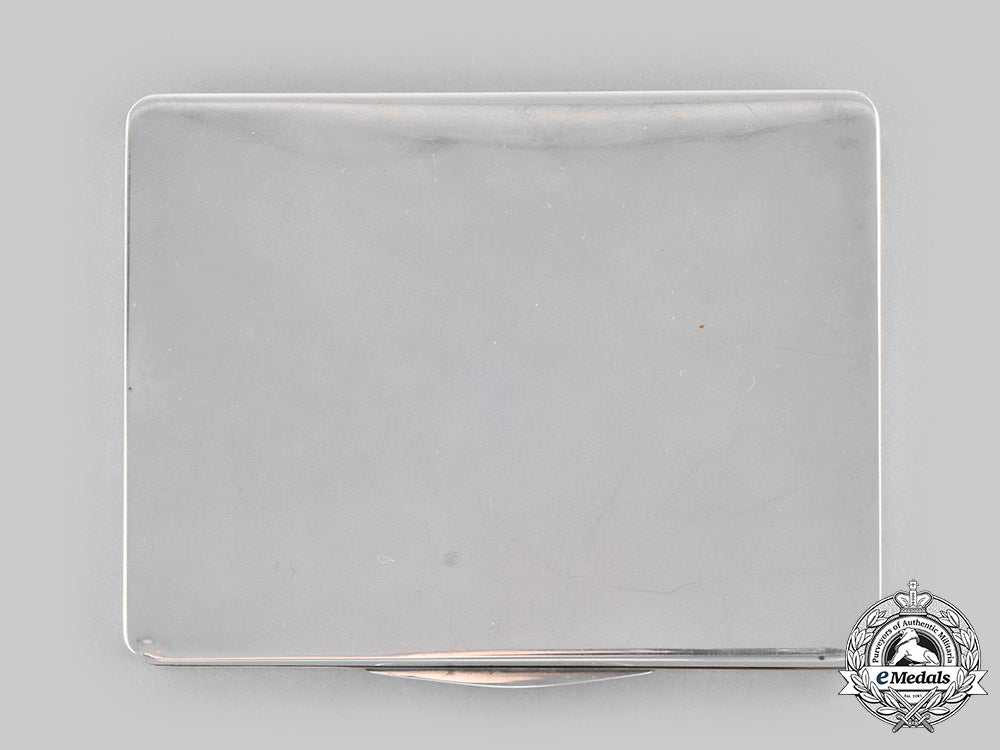
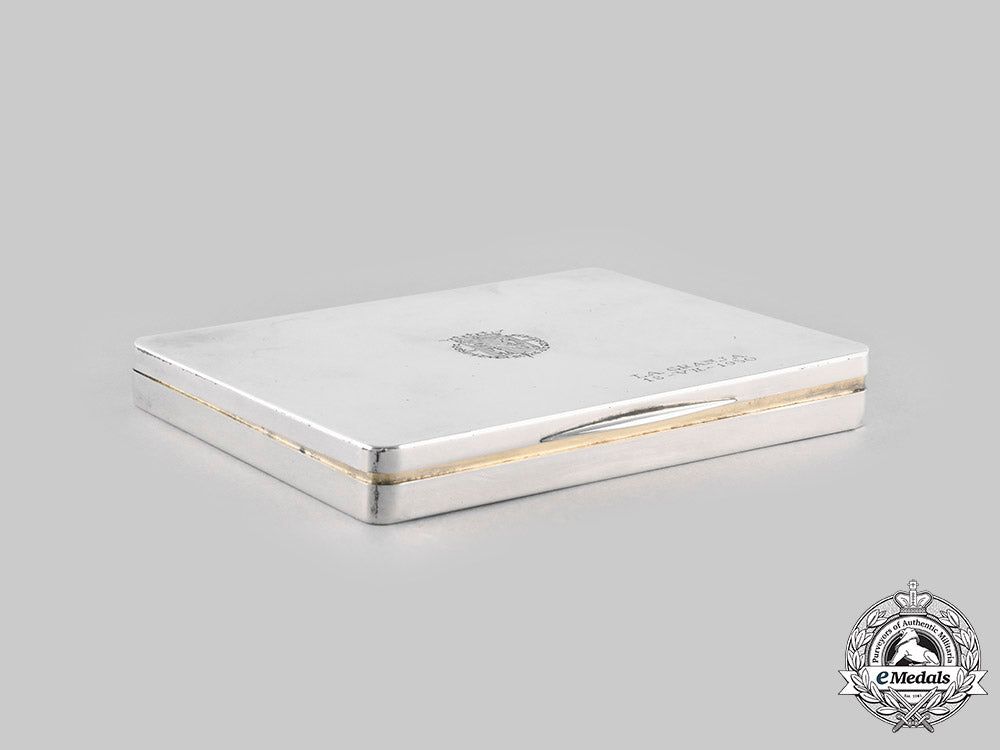
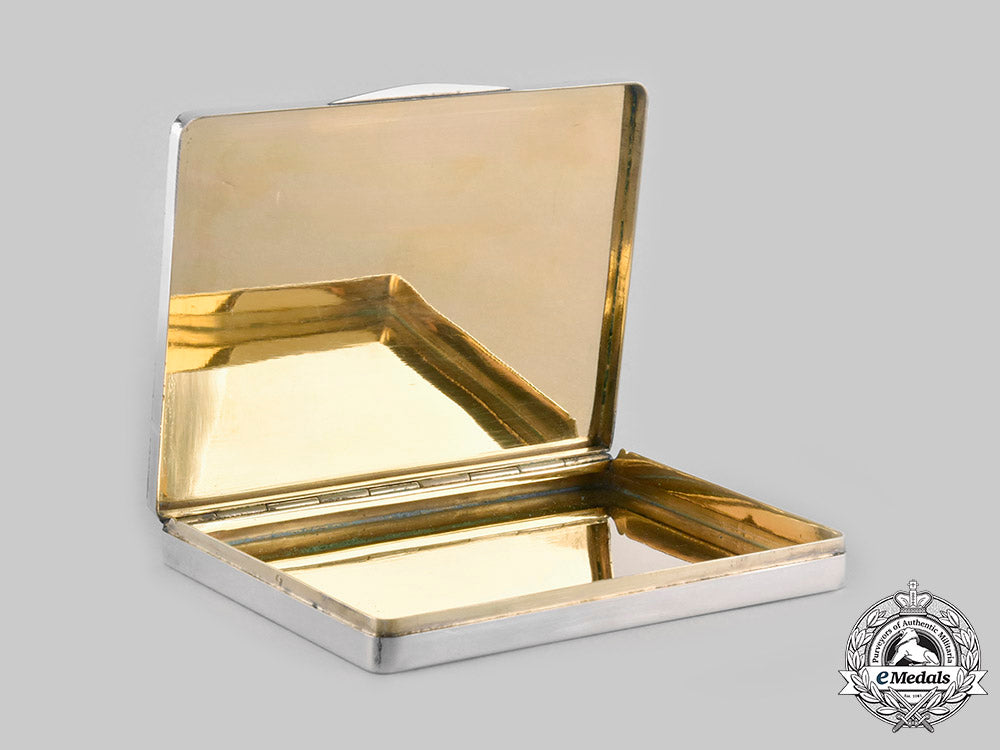
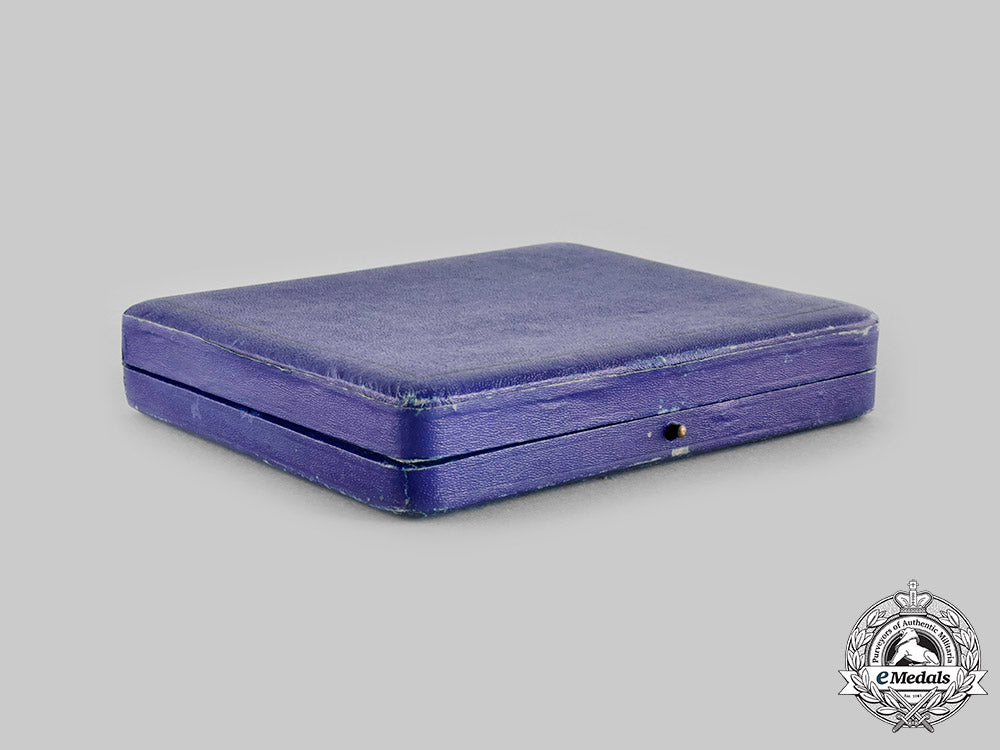
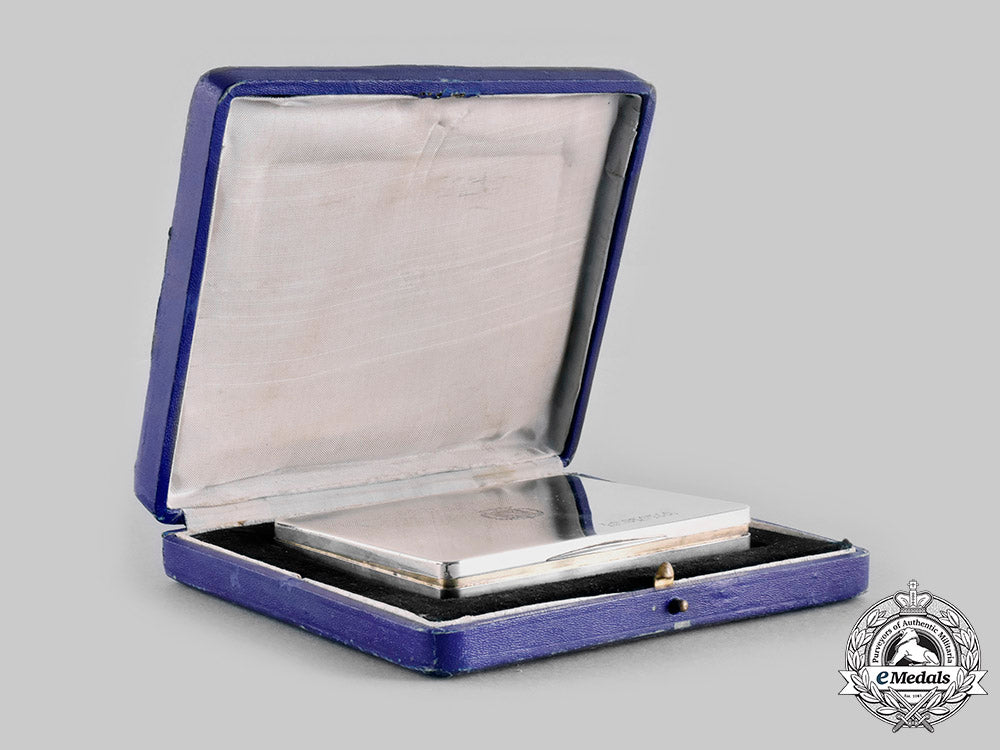
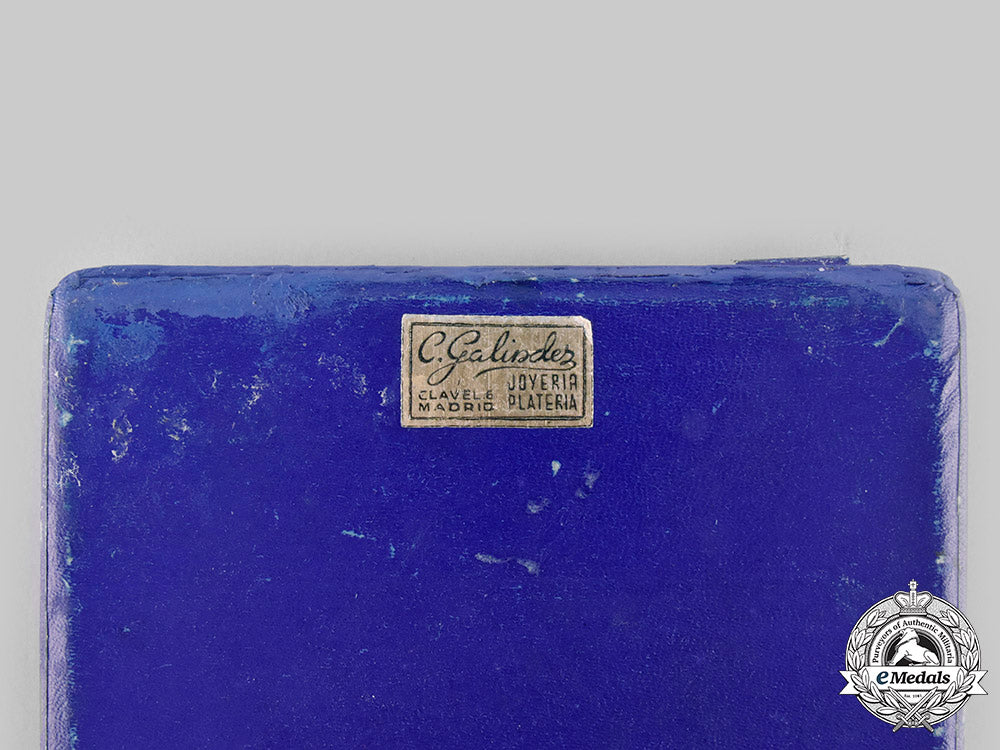
You May Also Like
Germany, Third Reich. A Mixed Lot of Tyrolean Marksmanship Badges
G52930
Germany, SS. An Estonian Waffen-SS Volunteer’s Sleeve Shield
G50381
Germany, SS. A Waffen-SS Sturmmann Sleeve Insignia
G52846
Germany, Third Reich; Slovakia, First Republic. A Mixed Lot of Wartime Postcards
G52905
Germany, Third Reich. A Pair of Tyrolean Marksmanship Badges
G52981
-
Germany, Third Reich. A Mixed Lot of Tyrolean Marksmanship Badges
G52930
Add to CartRegular price $135 USDRegular price $0 USD Sale price $135 USDUnit price / per -
Germany, SS. An Estonian Waffen-SS Volunteer’s Sleeve Shield
G50381
Add to CartRegular price $150 USDRegular price $0 USD Sale price $150 USDUnit price / per -
Germany, SS. A Waffen-SS Sturmmann Sleeve Insignia
G52846
Add to CartRegular price $135 USDRegular price $0 USD Sale price $135 USDUnit price / per -
Germany, Third Reich; Slovakia, First Republic. A Mixed Lot of Wartime Postcards
G52905
Add to CartRegular price $135 USDRegular price $0 USD Sale price $135 USDUnit price / per -
Germany, Third Reich. A Pair of Tyrolean Marksmanship Badges
G52981
Add to CartRegular price $135 USDRegular price $0 USD Sale price $135 USDUnit price / per
Do you have a similar item you are interested in selling?
Please complete the form and our client care representatives will contact you.
Sell Item